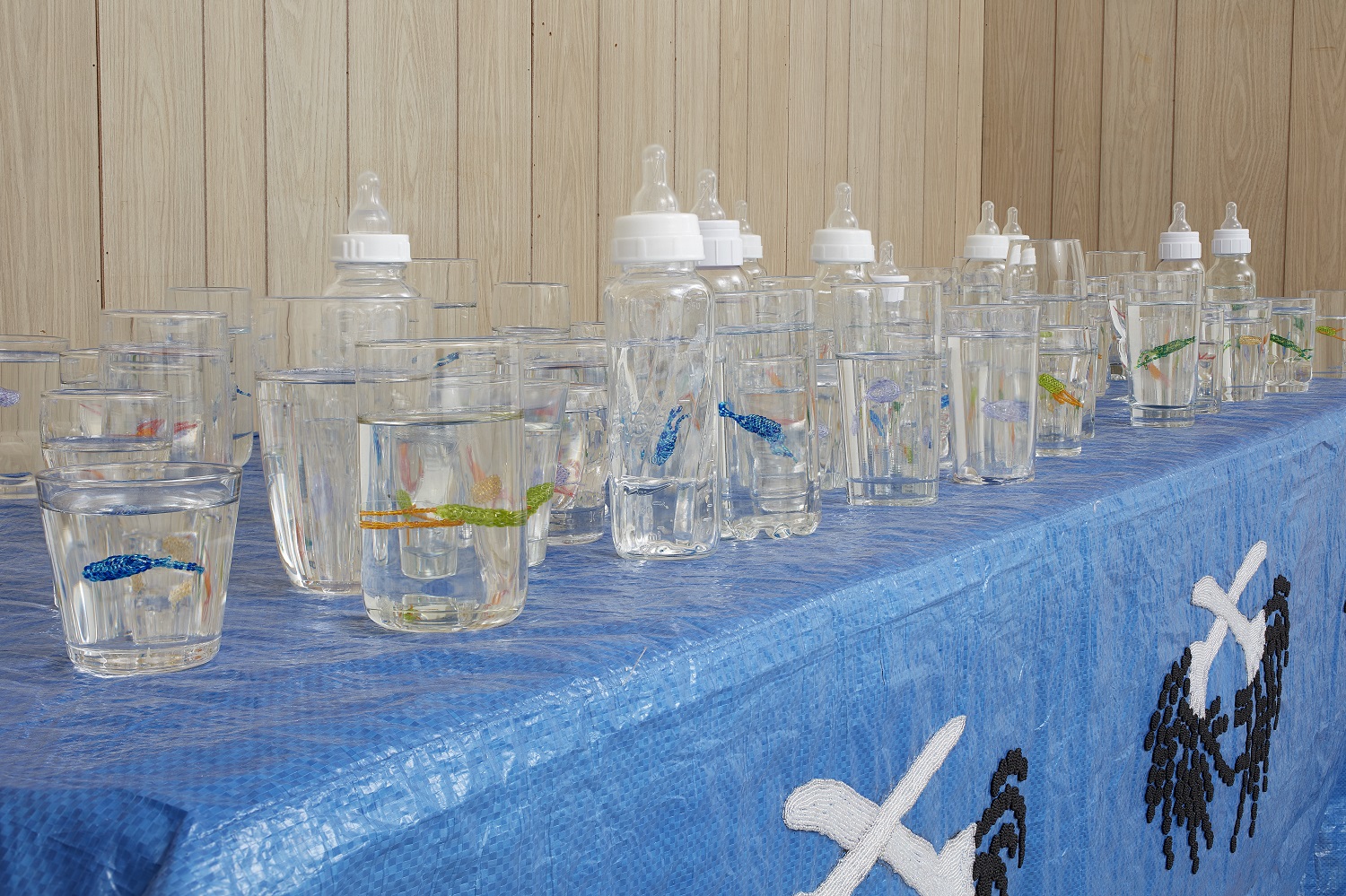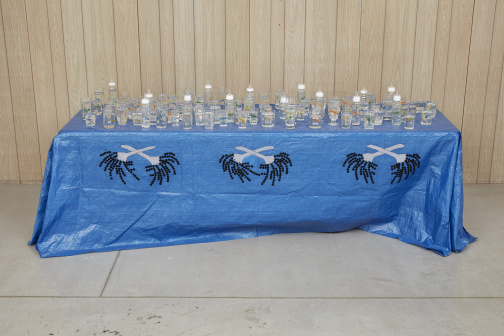Don’t Breathe, Don’t Drink

Ruth Cuthand. Don't Breathe, Don't Drink, 2016. 112 vessels with glass beads and resin, hand-beaded blue tarpaulin tablecloth, and 10 MDF "gas board" panels, Installed dimensions variable. Purchase, with funds from Karen Schreiber and Marnie Schreiber through The American Friends of the Art Gallery of Ontario, Inc., 2017. © Ruth Cuthand.
Visitors to the Every. Now. Then: Reframing Nationhood exhibition, which closed earlier in December, might remember entering one of the smaller rooms and coming upon an unexpected sight—a table, covered in blue tarp, in front of a wall of wood panelling. On top of the table were several water glasses and baby bottles, with exquisite pieces of beadwork appearing to float inside them.
What seems simple on the surface eventually reveals itself to be a moving piece of art, recently donated to our Collection by donors Marnie and Karen Schreiber. In Don’t Breathe, Don’t Drink, Ruth Cuthand, an artist of Plains Cree and Scottish ancestry, uses the Indigenous craft of beadwork to represent the deplorable conditions of many First Nation communities. Depicted on the tarp are magnified images of black mold, and inside the glasses the beadwork represents the bacterium and parasites found in the drinking water of approximately 94 First Nations. Don’t Breathe, Don’t Drink will be displayed again in the summer of 2018 as part of the AGO’s Look:Forward reinstallation project.
“Ruth Cuthand works cut deeply into the facade that hides the inequities in the treatment of First Nations. Don’t Breathe, Don’t Drink draws attention to the 94 communities without proper drinking water in one of the richest countries in the world,” said Wanda Nanibush, Curator, Indigenous Art at the AGO.
“I thought, ‘This is a work our audiences will be moved by’. When you see the installation you are drawn to the glasses and baby bottles with bright colours embedded within them. And as you get closer, the work changes. It’s a subtle and well-designed installation conveying the experience of the contamination of something so fundamental to our survival—water. Cuthand understands how to turn anger at an injustice into a poetic call for action.”
We spoke with Ruth Cuthand to learn more about how this powerful installation came together.
AGO: Where did you get the inspiration for Don’t Breathe, Don’t Drink?
Ruth: After Chief Theresa Spence alerted the Red Cross to the housing crisis on her reserve Attawapiskat, I started to think of conditions on reserves. As I watched the coverage on CBC, I was struck by the residents trying to build houses out of plastic tarps. This became the inspiration for the tablecloth. I wanted to make an embellished tablecloth out of the cheapest plastic tarp I could find. I beaded microscopic views of black mold in a decorative manner around the tablecloth.
I was also struck by the fact that there was unsafe drinking water on 94 reserves. They are forced to buy bottled water, have it shipped to the respective reserves and use it for everything from drinking to washing faces and bodies. If the reserves had to boil water for domestic use, then the house would be full of moisture and this added to the growth of black mold. In Canadian cities, we are taught that it is an immediate health crisis that needs to be dealt with. On reserve, the lack of decent, safe housing has forced more than one family to live in a house at a time. There is no place to go if black mold moves in.
AGO: The beadwork in it is fascinating, but why was it important to you to mix that with everyday elements like the blue tarp and the wall panels?
Ruth: In Don’t Breathe, Don’t Drink I have used a very domestic setting with the table, glasses and fake wood paneling. This paneling is known by firefighters as “gas” board because of its volatility. The bacterium and parasite in the glasses of resin are based on the six most common found in Reserve water. They are beaded in the various shapes and the first time I have beaded in 3D. I have used glasses of all sizes and baby bottles to represent the families that are affected.
AGO: What interests you about the tension between the inherent beauty in your beadwork and the ugly, harmful germs they represent?
Ruth: I like to work with themes that are often overlooked and produce it in the beauty of beads. Beads are often seen as an Indigenous material used in crafts and sold to the public. I have taken this modest material and used it to produce art that is both beautiful and ugly. Disease and health have been the focus of my work for the past 12 years. The work is time consuming and “women’s” work.
AGO: Why is this an important work to see right now?
Ruth: When Justin Trudeau was elected, he promised to get rid of water warnings on reserve. I want to remind Canadians that this is a serious problem that needs to be fixed. How can we sell our water to other countries, when we can’t provide clean drinking water to our own citizens?
Don’t Breathe, Don’t Drink was purchased with funds from Karen Schreiber and Marnie Schreiber through The American Friends of the Art Gallery of Ontario, Inc., 2017.
Are you an AGOinsider yet? If not, sign up to have stories like these delivered straight to your inbox every week.



